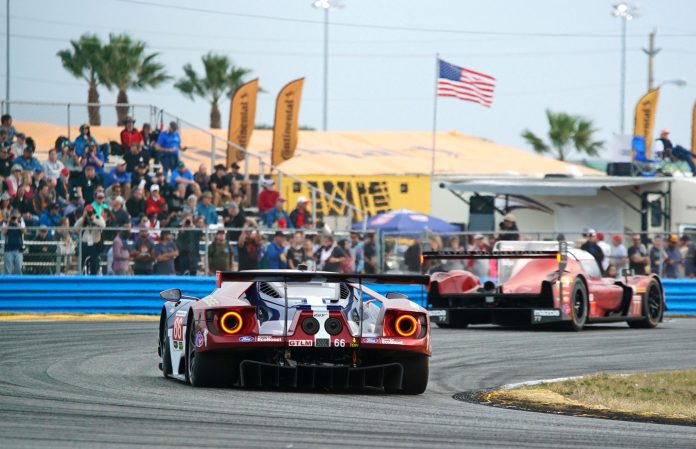At the Motul Petit Le Mans last month at Road Atlanta, there were a total of nine race cars riding on Michelin tires, and all of them were racing in the IMSA WeatherTech SportsCar Championship GT Le Mans (GTLM) class.
When the 2019 season begins in January, Michelin will be providing tires for more than 100 race cars across three IMSA-sanctioned series and seven different classes of race cars as the new “Official Tire of IMSA.”
All four WeatherTech Championship classes – Daytona Prototype international (DPi), LMP2, GTLM and GT Daytona (GTD) – will use Michelins, as will both the Grand Sport (GS) and TCR classes in the newly renamed MICHELIN Pilot Challenge. Both of those series will kick off their 2019 seasons at Daytona International Speedway on the last weekend in January as part of the prestigious Rolex 24 At Daytona weekend.
And that’s three weekends after the IMSA Prototype Challenge series, with an entire field of LMP3 race cars, opens its 2019 season with a three-hour race on the Roar Before the Rolex 24 At Daytona weekend that also will feature WeatherTech Championship and MICHELIN Pilot Challenge testing.
It’s a tall task, to be sure, but one that Michelin has been gearing up to take on since last year.
“It really started before we knew we had the business,” said Michelin North America Motorsports Technical Director Ken Payne, who is overseeing the IMSA project. “Looking at the different classes and the cars being fielded and the range of tires to gain an understanding of what the scope of sizes, relative performance needs and such would be. Once we knew we had been awarded the business, it was ‘Get to work’ on figuring out exactly which tires we wanted to consider for use.”
GTLM teams have routinely used what Michelin refers to as “confidential” tires, which are developed specifically for each of those cars’ use, and those cars will remain on confidentials next season. The DPi and LMP2 prototypes will use what Payne referred to as “semi-confidential” tires, while the GTD class, both MICHELIN Pilot Challenge classes and the LMP3 cars will use what Michelin considers as “commercial” tires.
No, not “commercial” in the sense of them being the same Michelin tires you purchase from your local dealer and use on your daily driver. But if you had a race car and were competing in events at places around the world where Michelin had authorized race tire distributors, you’d be able to purchase and use these tires or something similar.
“The tires have a wide operating range,” Payne said. “They’re progressive, they’re forgiving, they give a lot of good feedback to the driver as to how they’re performing, so it’s really a product that’s quite suitable to the task at hand.”
The availability of commercial tires for almost all of the cars competing enabled Michelin to get ahead in preparation for the 2019 season. What also has been valuable is a series of “track opportunities,” which were test sessions at selected IMSA racetracks during the course of the 2018 season for competitors to sample Michelin tires. There already have been five opportunities this year, with a sixth planned for next month.
“It gave us the opportunity to begin building a working relationship technically with the teams and to get some first-hand feedback on how our tires were performing,” said Payne. “We have done that multiple times now at Road Atlanta, at Daytona, we’ve been to Watkins Glen twice, we did that at Road America and we’ve managed to work with teams from LMP3, TCR, GS, GTD and the Prototype category over a mix of cars.”
In many cases, the opportunities validated what Michelin predicted would be suitable tires for each car and class. On a couple of occasions, it revealed the need to make some revisions.
“During this process, we uncovered a few things, particularly on the Prototype range, where we’d envisioned since the DPis are more or less based off of an LMP2-type chassis, that we would just apply our LMP2 tires used from the World Endurance Championship,” Payne said. “We quickly determined that the tires in play in that series, which is an open-tire category, were really not optimized for the tracks and temperature conditions that we run here in the IMSA series. So, we began work with our colleagues in France for a slight change in those tires to offer what will now be considered the ‘IMSA Medium’ and ‘IMSA Hot,’ or ‘IMSA Hard.’”
Payne is looking forward to this weekend’s four-hour IMSA Michelin SportsCar Encore at Sebring International Raceway and the opportunity it will provide to gather even more data prior to the start of the 2019 season.
“We consider that our first real, ‘trial by fire’ opportunity, because we have an expanded field of cars and the new classes to work with,” Payne said. “For the most part, I’d say we’re in pretty good shape. We’ve had the occasional unexpected surprise here and there. The need to do a slight revision to our Prototype tires was something that was not really anticipated, but we’re in good shape there.
“We have been delighted by the performance and the feedback we’re receiving from teams that have run our standard commercial product in GTD, GS, TCR and LMP3. We’ve had positive feedback and a lot of very useful feedback as we’ve been sorting out which tires to apply at which track.”
Beyond the on-track development, Payne and his colleagues have been working to expand their team to meet the increased demands of supplying so many cars.
“At the beginning of this year, we embarked on the manpower side,” Payne said. “Michelin prides itself in offering solid technical support at the track for our partner teams. As we have done in GTLM, the bulk of the people that are providing that assistance on pit lane and in the paddock are volunteers that come from elsewhere within the Michelin organization.
“While we have a highly capable full-time motorsports staff, it’s not nearly large enough to cover the field, so we recognized very early on the pool of volunteers that we need has to expand substantially, on the order of triple in size. So, as early as the Roar this year, we had small groups of new weekend support, or what new now call, ‘Motorsport Tire Specialists,’ in training.”
Payne estimates there will be 45 Motorsport Tire Specialists in place for the 2019 season. It’s all part of a colossal undertaking for Michelin.
“We have not had anything in Michelin Motorsport in North America remotely approaching this size, and globally, this is the largest scale of cars on a given weekend,” he said.









